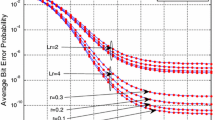Abstract
In realistic scenarios, multipath scattering environments usually require an approach which can easily model signal behavior. We have considered a Rayleigh multipath scattering channel. The multipath scattering environment captures degradation of signals in fading channels. In this paper, performance of the channel is investigated through the distribution of mutual information in the multipath scattering channel using matrix method. The probability density function for multipath scattering channels is still a developing area of research. The need of the hour is performance evaluation of these communication links in an efficient manner. By using techniques of probability theory, the variance of mutual information is derived for multiple cases based on fading environment. In this paper, we have considered a matrix based multipath scattering model for communication link. We have derived closed-form expression for mutual information in a multipath scattering channel. The matrix method is used to substitute this effect in terms of the Gaussian distribution. This substitution will prove to be very accurate for different cases as analyzed in this paper.









Similar content being viewed by others
References
Stüber, G. L. (2012). Principles of mobile communications (3rd ed.). Berlin: Springer.
Tse, D., & Viswanath, P. (2005). Fundamentals of wireless communications. Cambridge: Cambridge University Press.
Gesbert, D., Bolcskei, H., Gore, D. A., & Paulraj, A. J. (2002). Outdoor MIMO wireless channels: models and performance prediction. IEEE Transactions on Communications, 50(12), 1926–1934.
Moustakas, A. L., Simon, S. H., & Sengupta, A. M. (2003). MIMO capacity through correlated channels in the presence of correlated interferers and noise: A (not so) large N analysis. IEEE Transactions on Information Theory, 49(10), 2545–2561.
Debbah, M., & Muller, R. R. (2005). MIMO channel modeling and the principle of maximum entropy. IEEE Transactions on Information Theory, 51(5), 1667–1690.
Wei, L., Zheng, Z., Corander, J., & Taricco, G. (2015). On the outage capacity of orthogonal space-time block codes over multi-cluster scattering MIMO channels. IEEE Transactions on Communications, 63(5), 1700–1711.
Simon, S. H., Moustakas, A. L., & Marinelli, L. (2006). Capacity and character expansions: Moment-generating function and other exact results for MIMO correlated channels. IEEE Transactions on Information Theory, 52(12), 5336–5351.
Guo, D., Shamai, S., & Verdu, S. (2005). Mutual information and minimum mean-square error in Gaussian channels. IEEE Transactions on Information Theory, 51(5), 1261–1282.
Palomar, D. P., & Verdu, S. (2006). Gradient of mutual information in linear vector Gaussian channels. IEEE Transactions on Information Theory, 52(1), 141–154.
Wei, L., Zheng, Z., Tirkkonen, O., & Hamalainen, J. (2013). On the ergodic mutual information of multiple cluster scattering MIMO channels. IEEE Communication Letters, 17(9), 1700–1703.
Hoydis, J., Couillet, R., & Debbah, M. (2011). Asymptotic analysis of doublescattering channels. In 45th Asilomar conference on signals, systems and computers (ASILOMAR) (pp. 1935–1939).
Kamath, M. A., & Hughes, B. L. (2005). The asymptotic capacity of multiple antenna Rayleigh fading channels. IEEE Transactions on Information Theory, 51(12), 4325–4333.
Bai, Z. D. (1993). Convergence rate of expected spectral distributions of large random matrices. Part I. Wigner matrices. The Annals of Probability, 21(2), 625–648.
Mingo, J. A., & Speicher, R. (2006). Second order freeness and fluctuations of random matrices: I. Gaussian and Wishart matrices and cyclic Fock spaces. Journal of Functional Analysis, 235(1), 226–270.
Lozano, A., & Jindal, N. (2012). Are yesterday’s information-theoretic fading models and performance metrics adequate for the analysis of today’s wireless systems. IEEE Communication Magazine, 50(11), 210–217.
Speicher, R. (2014) Free probability and random matrices. In Proceedings of international congress of mathematicians, Seoul, Korea, August 13–21, 2014.
Vu, H. V., Tran, N. H., Nguyen, T. V., & Hariharan, S. I. (2014). Estimating information rates of Bernoulli-Gaussian impulsive noise channels in Rayleigh fading. IEEE Transactions on Information Theory, 62(6), 1845–1856.
Gradshteyn, I. S., & Ryzhik, I. M. (2000). Tables of integrals, series, and products (6th ed.). New York: Academic Press.
Abramowitz, M., & Stegun, I. A. (1972). Handbook of mathematical functions (9th ed.). New York: Dover.
Nica, A., & Speicher, R. (2006). Lectures on the combinatorics of free probability. Cambridge: Cambridge University Press.
Duncan, T. E. (1970). On the calculation of mutual information. SIAM Journal on Applied Mathematics, 19, 215–220.
Muller, K. (2001). Computing the confluent hypergeometric function, M (a, b, x). Numerische Mathematik, 90(1), 179–196.
Voiculescu, D. (1986). Addition of certain non-commuting random variables. Journal of Functional Analysis, 66, 323–346.
Author information
Authors and Affiliations
Corresponding author
Rights and permissions
About this article
Cite this article
Dhaka, A., Chauhan, S., Bhaskar, V. et al. Statistical Approach for Performance Analysis of Multipath Scattering Environment. Wireless Pers Commun 98, 743–757 (2018). https://doi.org/10.1007/s11277-017-4893-9
Published:
Issue Date:
DOI: https://doi.org/10.1007/s11277-017-4893-9




